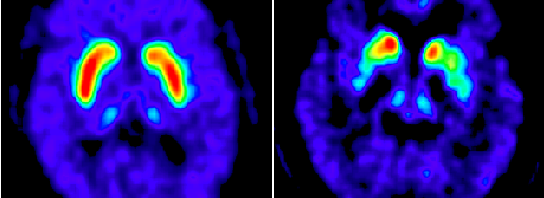Merriam webster’s dictionary defines Parkinson’s disease as “a chronic progressive neurological disease chiefly of later life that is linked to decreased dopamine production in the substantia nigra and is marked especially by tremor of resting muscles, rigidity, slowness of movement, impaired balance, and a shuffling gait.”
A nice balance between dopamine and acetylcholine is key to motor control. Dopamine also plays an important role in many other bodily functions and neurotransmissions. For Parkinson’s disease the biggest issue is the imbalance between dopamine and acetylcholine, because of the decreased dopamine production.
Researchers so far have had a difficult time pinpointing what is causing the neuronal damage leading to Parkinson’s and other related diseases. Some environmental factors for Parkinson’s disease include increased age, being a male, head injury, occupation, area of residence, , pesticide exposure, exposure to metals, genetic predisposition, solvents and PCBs.
For a lot of these factors we can’t really do a whole lot until it is too late and the damage has already begun. These factors also don’t necessarily lead to Parkinson’s, but do increase your chances.
There is no way of getting around the fact that an increase in age will increase your chances of Parkinson’s and being a male will also increase your chances. Acquiring a head injury could lead to any number of related issues, but those are typically out of a person’s control. The occupation you choose could have some side effects that come with it depending on what you are exposed to. Jobs where you may be exposed to toxic chemicals and metals could increase your chances of developing disease.
Where you live could be a factor in your Parkinson’s chances. It could be environmental factors of the specific area that you live in, but it could also be related to the gene pool in your area. Maybe the fields around you are spraying pesticides or the place where you get your produce uses chemicals that could lead to an increased risk. Say you take away pesticides, then we have more of a risk acquiring an insect transported disease.
The Parkinson’s Disease Foundation also listed some potential protective factors. Caffeine, anti-inflammatory drugs, exercise, and vitamin D have been found to have positive effects on the brain. Some controversial protective factors included uric acid, taking drugs that lower your cholesterol, and nicotine.
Males with high amounts of uric acid tend to form kidney stones, but they also have an lower risk of developing Parkinson’s. If you have high cholesterol and take drugs to lower your cholesterol then you will have a lower chance of getting Parkinson’s, but your health wasn’t good to begin with because you had high cholesterol. If you naturally have low cholesterol your chances of developing Parkinson’s disease is higher. There has been a correlation between smoking and neuronal damage. Researches believe that nicotine may block the destruction of the neurons that leads to Parkinson’s.

These simple everyday factors are a lot like the proteins and enzymes in our body that we talk about in class. In one place they are doing a really great thing, but in another place they are destroying us. Why would our body be producing things that our toxic to us? With almost everything we do there are potential benefits and drawbacks. Our bodies weren’t meant to live forever and longer we live the more we are beginning to understand and fight that.
Parkinson's Disease: Finding the Balance
